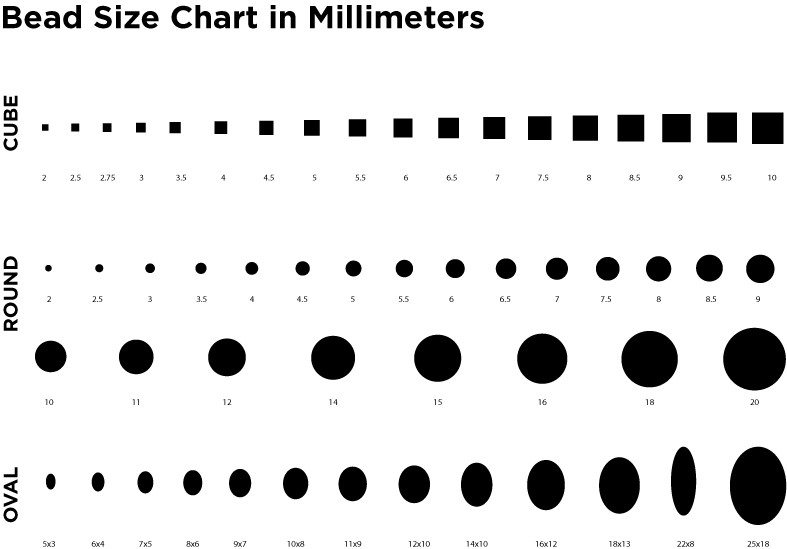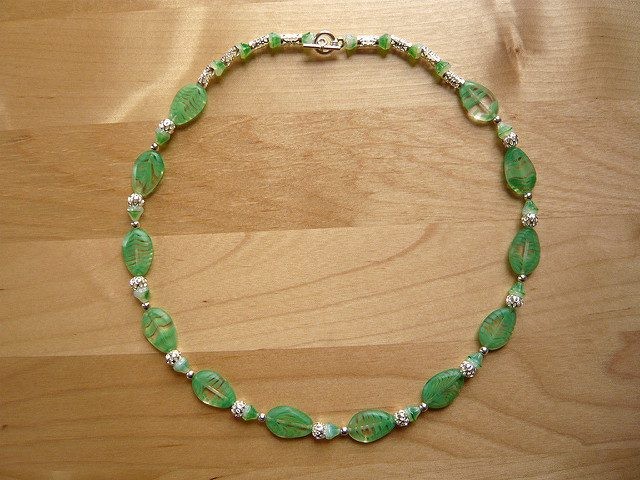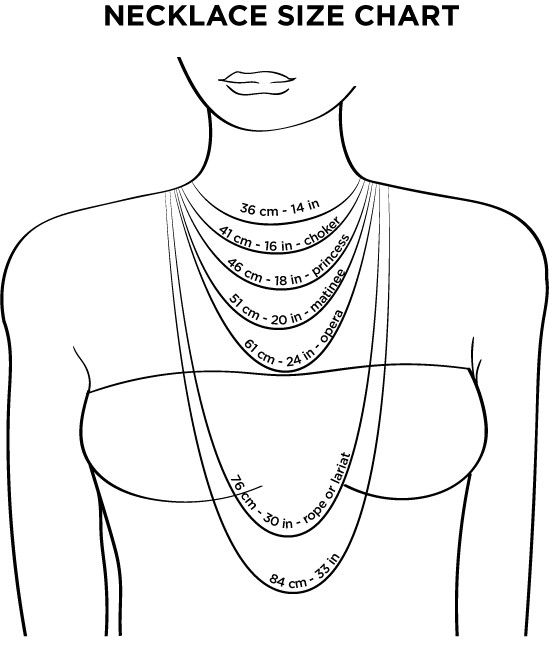Navigating the world of beads can be overwhelming, but CONDUCT.EDU.VN simplifies the process with this comprehensive Bead Size Guide, covering everything from bead dimensions to necklace lengths. This resource offers detailed charts, conversion tools, and expert advice to help you choose the perfect beads for your jewelry making projects, ensuring precision and professional results. Explore our guides on jewelry making, bead terminology, and necklace design.
1. Understanding Bead Sizes: A Comprehensive Guide
Bead sizes are typically measured in millimeters (mm). Understanding these measurements is crucial for various crafting projects, especially jewelry making. Different sizes create different effects, and knowing the exact dimensions helps in planning and executing designs precisely.
1.1. Why Bead Size Matters
The size of a bead influences the overall look, feel, and functionality of your creation. Whether you’re stringing delicate necklaces, creating intricate patterns, or embellishing clothing, the right bead size can make all the difference.
1.2. Common Bead Sizes
Beads come in a wide range of sizes, but some are more commonly used than others. Here’s a quick overview:
- 2mm to 4mm: Ideal for delicate work like seed beading, creating fine details, or adding subtle accents to jewelry.
- 6mm to 8mm: Versatile sizes suitable for necklaces, bracelets, and earrings. They strike a balance between visibility and comfort.
- 10mm to 12mm: Larger beads that make a statement. Perfect for focal beads in necklaces or chunky bracelets.
- 14mm and larger: These are typically used as feature elements in jewelry or in home décor projects.
1.3. How Bead Size Affects Design
Consider the impact of bead size on your design’s weight, drape, and visual appeal. Smaller beads are lighter and allow for more intricate patterns, while larger beads add weight and can create bolder, simpler designs.
2. Bead Size Chart: Beads per Inch
This chart provides a quick reference for determining how many beads of a specific size will fit within an inch, which is useful when planning the length of a beaded strand.
| Bead Size (mm) | Beads per Inch | Beads per 16″ Strand | Beads per 24″ Strand |
|---|---|---|---|
| 2 mm | 12.5 | 200 | 300 |
| 3 mm | 8.3 | 133 | 200 |
| 4 mm | 6.25 | 100 | 150 |
| 5 mm | 5 | 80 | 120 |
| 6 mm | 4.2 | 66 | 99 |
| 7 mm | 3.6 | 57 | 86 |
| 8 mm | 3.13 | 50 | 75 |
| 10 mm | 2.5 | 40 | 60 |
| 12 mm | 2.1 | 33 | 50 |



3. Choosing the Right Bead Size for Your Project
Selecting the appropriate bead size depends on the type of project, the desired aesthetic, and practical considerations like weight and comfort.
3.1. For Necklaces
Necklaces can accommodate a wide range of bead sizes. For delicate necklaces, smaller beads (2mm to 6mm) are ideal. For statement pieces, larger beads (8mm and up) can be used. Consider the length of the necklace and the overall style you’re aiming for.
3.2. For Bracelets
Bracelets need to be comfortable to wear, so bead size is crucial. Smaller to medium-sized beads (4mm to 8mm) are generally preferred. Elastic bracelets can handle larger beads, but remember to consider the weight.
3.3. For Earrings
Earrings should be lightweight to avoid discomfort. Small beads (2mm to 6mm) are best. For dangle earrings, consider using a mix of small and medium-sized beads to create an interesting visual effect without adding too much weight.
3.4. For Clothing Embellishments
When embellishing clothing, choose bead sizes that complement the fabric and design. Smaller beads (2mm to 4mm) are suitable for intricate patterns, while larger beads can be used as accents or focal points.
4. Cord Conversion Chart: Matching Cord to Bead Size
Selecting the right cord size is crucial for ensuring the durability and aesthetic appeal of your beaded jewelry. A cord that is too thin may break, while one that is too thick may not fit through the bead holes or may create an unappealing look.
4.1. Types of Cords
- Silk: Traditional choice, known for its strength and flexibility.
- Nylon: Durable and resistant to wear, a popular alternative to silk.
- Polyester: Similar to nylon, offering excellent strength and longevity.
4.2. Cord Sizing
Cords are typically sized using either letters (e.g., A, B, C) or numbers (e.g., 1, 2, 3). The following chart provides a general guideline for matching cord size to bead size:
| Silk Cord Size | Nylon Cord Size |
|---|---|
| A | 1 |
| B | 1.5 |
| C | 2 |
| D | 3 |
| E | 4 |
| F | 5 |
| FF | 8 |
4.3. Tips for Selecting Cord Size
- Consider the Bead Hole Size: Ensure the cord can pass through the bead hole easily.
- Match Cord Strength to Bead Weight: Use thicker, stronger cords for heavier beads.
- Test Before Committing: Always test a small section to ensure the cord and bead combination works well.
5. Necklace Lengths: A Visual Guide
Necklace length is a key factor in determining how the necklace will look and feel when worn. Different lengths complement different necklines and body types.
5.1. Standard Necklace Lengths
- Choker: 14 to 16 inches, sits snugly around the neck.
- Princess: 18 inches, a classic length that falls at the collarbone.
- Matinee: 20 to 24 inches, falls to the top of the bust.
- Opera: 28 to 32 inches, can be worn as a single long strand or doubled.
- Rope: Anything longer than 32 inches, offering versatility in styling.
5.2. How to Choose the Right Length
- Consider the Neckline: Shorter necklaces work well with open necklines, while longer necklaces complement higher necklines.
- Think About Body Type: Longer necklaces can elongate the torso, while shorter necklaces can accentuate the neck and shoulders.
- Personal Style: Choose a length that reflects your personal style and the look you want to achieve.
6. Printable Charts: Quick References
For your convenience, CONDUCT.EDU.VN offers printable charts that you can keep on hand while working on your projects. These charts provide quick references for bead sizes, cord conversions, and necklace lengths.
6.1. Bead Size Chart PDF
This printable chart includes bead sizes in millimeters, beads per inch, and estimated beads for 16″ and 24″ strands. It’s a handy tool for planning and estimating material needs.
6.2. Necklace Size Chart PDF
This chart visually illustrates standard necklace lengths and their placement on the body. It’s a great resource for designing necklaces that flatter different necklines and body types.
7. Types of Beads: Materials and Shapes
Beads come in a vast array of materials and shapes, each offering unique characteristics and aesthetic appeal. Understanding these differences can enhance your creativity and allow you to create truly unique pieces.
7.1. Bead Materials
- Glass Beads: Available in various colors, finishes, and shapes. Popular for their versatility and affordability.
- Gemstone Beads: Made from natural gemstones, offering unique colors and patterns. Often used in high-end jewelry.
- Metal Beads: Made from metals like sterling silver, gold, or copper. Add a touch of elegance and durability to designs.
- Wood Beads: Lightweight and natural, perfect for casual and bohemian styles.
- Plastic Beads: Affordable and available in a wide range of colors and shapes. Suitable for children’s crafts and costume jewelry.
- Ceramic Beads: Offer a rustic and artisanal look. Often hand-painted and unique.
7.2. Bead Shapes
- Round Beads: Classic and versatile. Can be used in a wide range of projects.
- Seed Beads: Small, round beads used for intricate beadwork and embroidery.
- Tube Beads: Cylindrical beads that add a linear element to designs.
- Cube Beads: Square-shaped beads that create a geometric look.
- Faceted Beads: Beads with multiple flat surfaces that reflect light beautifully.
- Bugle Beads: Long, thin beads that add texture and movement to designs.
8. Tips for Accurate Measurement
Accurate measurement is essential for successful beading projects. Here are some tips to ensure precision:
8.1. Use a Caliper
A caliper is a precise measuring tool that can accurately measure the diameter of beads. It’s especially useful for measuring small beads and ensuring consistency in size.
8.2. Invest in a Bead Sizing Tool
Bead sizing tools are designed to quickly and accurately measure bead sizes. They typically consist of a series of holes or slots corresponding to different bead sizes.
8.3. Check Multiple Beads
Beads can vary slightly in size, even within the same batch. To ensure accuracy, measure multiple beads and calculate the average size.
8.4. Account for Coating and Finishes
Coatings and finishes can add to the overall size of a bead. When measuring, take these into account to avoid discrepancies.
9. Advanced Techniques: Bead Weaving and Stringing
Once you have a good understanding of bead sizes and materials, you can explore more advanced beading techniques like bead weaving and stringing.
9.1. Bead Weaving
Bead weaving involves using thread to create intricate patterns and designs with beads. Common bead weaving techniques include:
- Peyote Stitch: A versatile stitch that creates a flat, even fabric.
- Brick Stitch: Similar to peyote stitch, but creates a staggered, brick-like pattern.
- Loom Weaving: Using a loom to create larger, more complex designs.
9.2. Bead Stringing
Bead stringing involves threading beads onto a cord or wire to create necklaces, bracelets, and other jewelry items. Key considerations for bead stringing include:
- Choosing the Right Cord: Select a cord that is strong, durable, and matches the bead size.
- Using Crimps and Clasps: Secure the ends of the strand with crimps and clasps to prevent the beads from falling off.
- Creating Balanced Designs: Arrange the beads in a way that is visually appealing and balanced.
10. Resources for Further Learning
CONDUCT.EDU.VN offers a wealth of additional resources for learning about beads, jewelry making, and related topics.
10.1. Gemstone Encyclopedia
Browse our Gemstone Encyclopedia to discover a wide variety of gemstones that can be used as beads. Learn about their properties, colors, and origins.
10.2. Jewelry Making Tutorials
Access our collection of jewelry making tutorials to learn step-by-step techniques for creating necklaces, bracelets, earrings, and more.
10.3. Expert Articles
Read our expert articles on topics like bead nomenclature, jewelry design, and gemstone identification.
11. The Importance of Ethical Sourcing
As you delve deeper into the world of beads, it’s important to consider the ethical implications of sourcing materials. Ethical sourcing ensures that beads are produced in a way that respects human rights and protects the environment.
11.1. Fair Trade Beads
Look for beads that are certified as fair trade. Fair trade practices ensure that artisans and workers receive fair wages and work in safe conditions.
11.2. Sustainable Materials
Choose beads made from sustainable materials, such as recycled glass, wood from sustainably managed forests, or lab-grown gemstones.
11.3. Transparency in Supply Chains
Support suppliers who are transparent about their supply chains. Transparency allows you to trace the origin of your beads and ensure that they were produced ethically.
12. Storing and Organizing Beads
Proper storage and organization can help you keep your beads in good condition and make it easier to find the ones you need for your projects.
12.1. Storage Containers
Use clear plastic containers with lids to store your beads. Label each container with the bead size, material, and color for easy identification.
12.2. Organization Systems
Create an organization system that works for you. You can organize your beads by size, color, material, or project type.
12.3. Protection from Light and Moisture
Store your beads in a cool, dry place away from direct sunlight. Exposure to light and moisture can damage certain types of beads.
13. Frequently Asked Questions (FAQ) About Bead Sizes
13.1. What is the standard unit of measurement for bead sizes?
The standard unit of measurement for bead sizes is millimeters (mm).
13.2. How do I measure the size of a bead?
You can measure the size of a bead using a caliper or a bead sizing tool.
13.3. What is the difference between seed beads and regular beads?
Seed beads are small, round beads that are typically used for intricate beadwork. Regular beads come in a wider range of sizes and shapes.
13.4. How many beads do I need for a 16-inch necklace?
The number of beads you need for a 16-inch necklace depends on the size of the beads. Refer to the bead size chart for guidance.
13.5. What size cord should I use for 8mm beads?
For 8mm beads, a nylon cord size 3 or 4 is typically recommended.
13.6. Can I mix different bead sizes in a single project?
Yes, you can mix different bead sizes in a single project to create visual interest and texture.
13.7. How do I choose the right bead size for earrings?
Choose small to medium-sized beads (2mm to 6mm) for earrings to avoid discomfort.
13.8. Where can I find printable bead size charts?
Printable bead size charts are available on CONDUCT.EDU.VN.
13.9. What are some popular bead materials?
Popular bead materials include glass, gemstone, metal, wood, and plastic.
13.10. How do I store and organize my beads?
Store your beads in clear plastic containers with lids, and organize them by size, color, or material.
14. Legal and Ethical Considerations
When working with beads and creating jewelry, it’s important to be aware of any legal and ethical considerations that may apply.
14.1. Intellectual Property
Respect the intellectual property rights of others. Do not copy or reproduce designs without permission.
14.2. Disclosure
Be transparent about the materials you use in your jewelry. Disclose whether beads are natural, synthetic, or treated in any way.
14.3. Safety
Ensure that your jewelry is safe to wear. Use lead-free materials and avoid sharp edges or other potential hazards.
15. Stay Updated with CONDUCT.EDU.VN
The world of beads and jewelry making is constantly evolving. Stay updated with the latest trends, techniques, and resources by following CONDUCT.EDU.VN.
15.1. Newsletter
Subscribe to our newsletter to receive updates on new articles, tutorials, and products.
15.2. Social Media
Follow us on social media to connect with other jewelry makers and share your creations.
15.3. Community Forum
Join our community forum to ask questions, share tips, and get feedback on your projects.
16. Conclusion: Mastering Bead Sizes for Stunning Creations
Understanding bead sizes is essential for creating beautiful, professional-looking jewelry and craft projects. With the help of this guide and the resources available on CONDUCT.EDU.VN, you can confidently select the right beads for your next creation. Remember to consider the project type, desired aesthetic, and practical considerations like weight and comfort.
For more detailed information and guidance on ethical practices and standards, visit CONDUCT.EDU.VN or contact us at 100 Ethics Plaza, Guideline City, CA 90210, United States, or via Whatsapp at +1 (707) 555-1234. Let conduct.edu.vn be your trusted resource for all things related to beads, jewelry making, and ethical craftsmanship.

